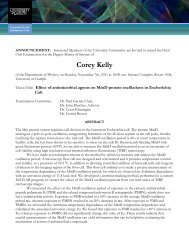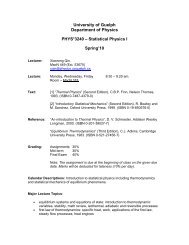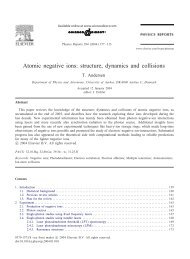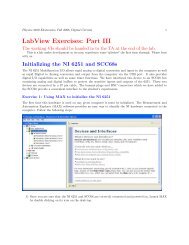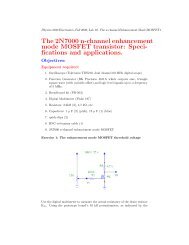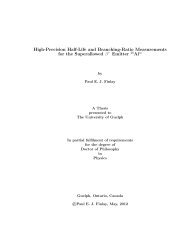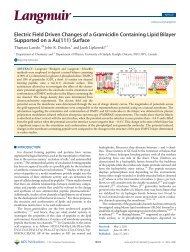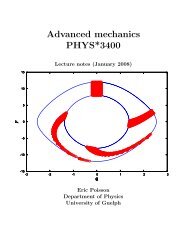Geant4 Simulations for the Radon Electric Dipole Moment Search at
Geant4 Simulations for the Radon Electric Dipole Moment Search at
Geant4 Simulations for the Radon Electric Dipole Moment Search at
Create successful ePaper yourself
Turn your PDF publications into a flip-book with our unique Google optimized e-Paper software.
3.6.2 Output D<strong>at</strong>a and Sort Codes<br />
The simul<strong>at</strong>ed d<strong>at</strong>a, described in Section 3.2.5, was written to binary files. The<br />
binaryfilesweresortedtogener<strong>at</strong>espectraandm<strong>at</strong>ricesfiles. Theenergyresolutionof<br />
<strong>the</strong> detectors was modelled during <strong>the</strong> sorting process, since <strong>the</strong> st<strong>at</strong>istical vari<strong>at</strong>ions<br />
and electronic effects th<strong>at</strong> give rise to <strong>the</strong> resolution can not be modelled directly by<br />
<strong>Geant4</strong> . The energies output from <strong>Geant4</strong> were idealized, within 1 keV bins. To<br />
facilit<strong>at</strong>e a comparison between experiment and simul<strong>at</strong>ion, a resolution function was<br />
applied, specific to <strong>the</strong> detector type.<br />
The rel<strong>at</strong>ionship between <strong>the</strong> square of <strong>the</strong> full-width <strong>at</strong> half-maximum (FWHM)<br />
and γ-ray energy was determined <strong>for</strong> each detector by fitting a second order polynomial.<br />
These coefficients <strong>for</strong> <strong>the</strong> TIGRESS/GRIFFIN detectors were previously<br />
calcul<strong>at</strong>ed and verified [35] and are shown in Figure 3.8(b). The coefficients <strong>for</strong> <strong>the</strong><br />
BrilLanCe380detectorswerefittoper<strong>for</strong>mancemeasurementsgivenbySaint-Gobain.<br />
Figure 3.8(a) illustr<strong>at</strong>es <strong>the</strong> measurements and <strong>the</strong> derived fit. The energy resolution<br />
values derived from <strong>the</strong>se functions were converted into standard devi<strong>at</strong>ions, and applied<br />
to <strong>the</strong> idealized energies. The resulting energies were chosen from a Gaussian<br />
distribution with <strong>the</strong> idealized energy as <strong>the</strong> mean [35].<br />
59



